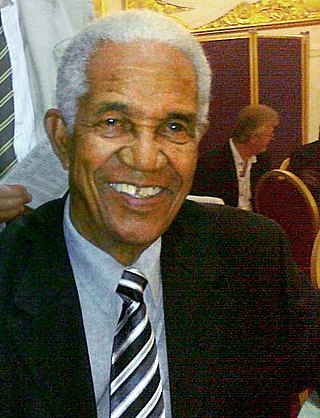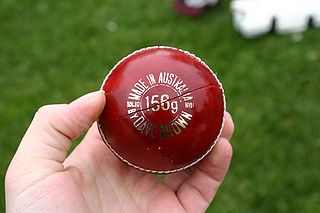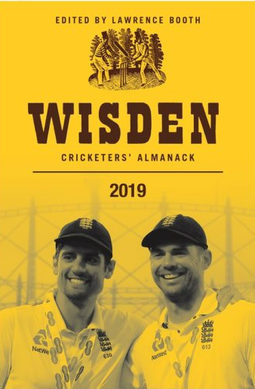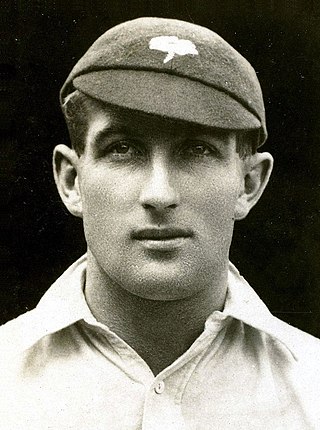Related Research Articles
First-class cricket, along with List A cricket and Twenty20 cricket, is one of the highest-standard forms of cricket. A first-class match is one of three or more days' scheduled duration between two sides of eleven players each and is officially adjudged to be worthy of the status by virtue of the standard of the competing teams. Matches must allow for the teams to play two innings each, although in practice a team might play only one innings or none at all.

Left-arm unorthodox spin, also known as slow left-arm wrist-spin, is a type of spin bowling in the sport of cricket. Left-arm unorthodox spin bowlers use wrist spin to spin the ball, and make it deviate, or 'turn' from left to right after pitching. The direction of turn is the same as that of a traditional right-handed off spin bowler, although the ball will usually turn more sharply due to the spin being imparted predominantly by the wrist.
Limited overs cricket, also known as one-day cricket or white ball cricket, is a version of the sport of cricket in which a match is generally completed in one day. There are a number of formats, including List A cricket, Twenty20 cricket, and 100-ball cricket. The name reflects the rule that in the match each team bowls a set maximum number of overs, usually between 20 and 50, although shorter and longer forms of limited overs cricket have been played.

Leg before wicket (lbw) is one of the ways in which a batsman can be dismissed in the sport of cricket. Following an appeal by the fielding side, the umpire may rule a batter out lbw if the ball would have struck the wicket but was instead intercepted by any part of the batter's body. The umpire's decision will depend on a number of criteria, including where the ball pitched, whether the ball hit in line with the wickets, the ball's expected future trajectory after hitting the batsman, and whether the batter was attempting to hit the ball.

Sir Garfield St Aubrun Sobers,, also known as Sir Gary or Sir Garry Sobers, is a former cricketer who played for the West Indies between 1954 and 1974. A highly skilled bowler, an aggressive batsman and an excellent fielder, he is widely considered to be cricket's greatest ever all-rounder and one of the greatest cricketers of all time.

The Australia men's national cricket team represents Australia in men's international cricket. As the joint oldest team in Test cricket history, playing in the first ever Test match in 1877, the team also plays One-Day International (ODI) and Twenty20 International (T20I) cricket, participating in both the first ODI, against England in the 1970–71 season and the first T20I, against New Zealand in the 2004–05 season, winning both games. The team draws its players from teams playing in the Australian domestic competitions – the Sheffield Shield, the Australian domestic limited-overs cricket tournament and the Big Bash League.

A cricket ball is a hard, solid ball used to play cricket. A cricket ball consists of a cork core wound with string then a leather cover stitched on, and manufacture is regulated by cricket law at first-class level. The trajectory of a cricket ball when bowled, through movement in the air, and off the ground, is influenced by the action of the bowler and the condition of the ball and the pitch, while working on the cricket ball to obtain optimal condition is a key role of the fielding side. The principal method through which the batsman scores runs is by hitting the ball, with the bat, into a position where it would be safe to take a run, or by directing the ball through or over the boundary. Cricket balls are harder and heavier than baseballs.

In cricket, a player's bowling average is the number of runs they have conceded per wicket taken. The lower the bowling average is, the better the bowler is performing. It is one of a number of statistics used to compare bowlers, commonly used alongside the economy rate and the strike rate to judge the overall performance of a bowler.

ESPNcricinfo is a sports news website exclusively for the game of cricket. The site features news, articles, live coverage of cricket matches, and StatsGuru, a database of historical matches and players from the 18th century to the present. As of March 2023, Sambit Bal was the editor.

Wisden Cricketers' Almanack, or simply Wisden, colloquially the Bible of Cricket, is a cricket reference book published annually in the United Kingdom. The description "bible of cricket" was first used in the 1930s by Alec Waugh in a review for the London Mercury. In October 2013, an all-time Test World XI was announced to mark the 150th anniversary of Wisden Cricketers' Almanack.

Wilfred Rhodes was an English professional cricketer who played 58 Test matches for England between 1899 and 1930. In Tests, Rhodes took 127 wickets and scored 2,325 runs, becoming the first Englishman to complete the double of 1,000 runs and 100 wickets in Test matches. He holds the world records both for the most appearances made in first-class cricket, and for the most wickets taken (4,204). He completed the double of 1,000 runs and 100 wickets in an English cricket season a record 16 times. Rhodes played for Yorkshire and England into his fifties, and in his final Test in 1930 was, at 52 years and 165 days, the oldest player who has appeared in a Test match.
The Duleep Trophy, also known as Mastercard Duleep trophy due to sponsorship reasons, is a domestic first-class cricket competition played in India. Named after Kumar Shri Duleepsinhji of Nawanagar, the competition was originally contested by teams representing geographical zones of India. Since 2016–17 it has been played by teams chosen by BCCI selectors. West Zone are the current champions.
The Association of Cricket Statisticians and Historians (ACS) was founded in England in 1973 for the purpose of researching and collating information about the history and statistics of cricket. Originally called the Association of Cricket Statisticians, the words "and Historians" were added in 1992 but it has continued to use the initialism ACS.

Abraham "Abe" Waddington, sometimes known as Abram Waddington, was a professional cricketer for Yorkshire, who played in two Test matches for England, both against Australia in 1920–21. Between 1919 and 1927 Waddington made 255 appearances for Yorkshire, and in all first-class cricket played 266 matches. In these games, he took a total of 852 wickets with his left arm fast-medium bowling. Capable of making the ball swing, Waddington was admired for the aesthetic quality of his bowling action. He was a hostile bowler who sometimes sledged opposing batsmen and questioned umpires' decisions, behaviour which was unusual during his playing days.

Dorset County Cricket Club is one of twenty National county clubs within the domestic cricket structure of England and Wales. It represents the historic county of Dorset.

The Rhodesia cricket team played first-class cricket and represented originally the British colony of Southern Rhodesia and later the unilaterally independent state of Rhodesia which became Zimbabwe. In 1980 the Rhodesia cricket team was renamed as the Zimbabwe-Rhodesia cricket team, and in 1981 it adopted its current name of the Zimbabwe national cricket team.
1864 was the 78th season of cricket in England. It was a significant year in cricket history, as it saw the legalisation of overarm bowling and the first edition of John Wisden's Cricketers' Almanac.
In the 1872 cricket season, the first experiment in pitch covering was carried out. Prince's Cricket Ground opened in Chelsea, London.

Cricket is a bat-and-ball game played between two teams of eleven players on a field at the centre of which is a 22-yard (20-metre) pitch with a wicket at each end, each comprising two bails balanced on three stumps. The batting side scores runs by striking the ball bowled at one of the wickets with the bat and then running between the wickets, while the bowling and fielding side tries to prevent this and dismiss each batter. Means of dismissal include being bowled, when the ball hits the stumps and dislodges the bails, and by the fielding side either catching the ball after it is hit by the bat, but before it hits the ground, or hitting a wicket with the ball before a batter can cross the crease in front of the wicket. When ten batters have been dismissed, the innings ends and the teams swap roles. The game is adjudicated by two umpires, aided by a third umpire and match referee in international matches. They communicate with two off-field scorers who record the match's statistical information.
References
- 1 2 Gavin Mortimer (6 June 2013). A History of Cricket in 100 Objects. Profile Books. pp. 106–. ISBN 978-1-84765-959-0.
- Cricinfo
- Wisden Cricketers' Almanack 1959 (Obituaries)